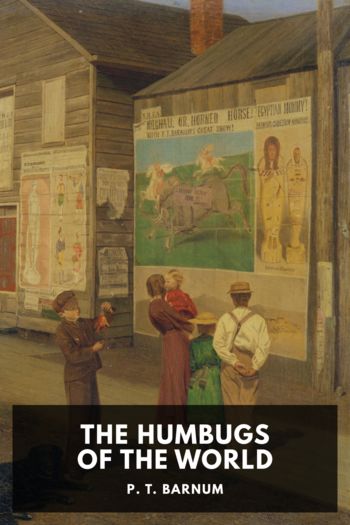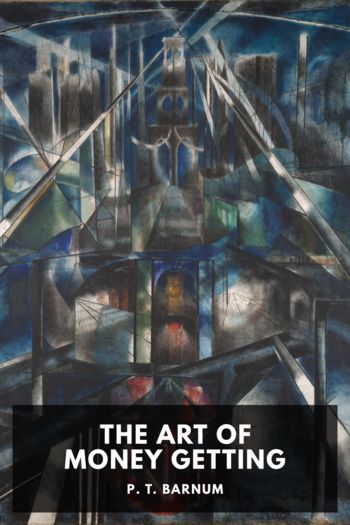The Humbugs of the World by P. T. Barnum (best contemporary novels .TXT) 📕

- Author: P. T. Barnum
Book online «The Humbugs of the World by P. T. Barnum (best contemporary novels .TXT) 📕». Author P. T. Barnum
On another occasion, a lady equally shrewd, who lives neighbor to me in Connecticut, after regarding for a few minutes the “Golden Angel Fish” swimming in one of the Aquaria, abruptly addressed me with:
“You can’t humbug me, Mr. Barnum; that fish is painted!”
“Nonsense!” said I, with a laugh; “the thing is impossible!”
“I don’t care, I know it is painted; it is as plain as can be.”
“But, my dear Mrs. H., paint would not adhere to a fish while in the water; and if it would, it would kill him. Besides,” I added, with an extra serious air, “we never allow humbugging here!”
“Oh, here is just the place to look for such things,” she replied with a smile; “and I must say I more than half believe that Angel Fish is painted.”
She was finally nearly convinced of her error, and left. In the afternoon of the same day, I met her in Old Adams’ California Menagerie. She knew that I was part-proprietor of that establishment, and seeing me in conversation with “Grizzly Adams,” she came up to me in some haste, and with her eyes glistening with excitement, she said:
“O, Mr. B., I never saw anything so beautiful as those elegant ‘Golden Pigeons’ from Australia. I want you to secure some of their eggs for me, and let my pigeons hatch them at home. I should prize them beyond all measure.”
“Oh, you don’t want ‘Golden Australian Pigeons,’ ” I replied; “they are painted.”
“No, they are not painted,” said she, with a laugh, “but I half think the Angel Fish is.”
I could not control myself at the curious coincidence, and I roared with laughter while I replied:
“Now, Mrs. H., I never let a good joke be spoiled, even if it serves to expose my own secrets. I assure you, upon honor, that the Golden Australian Pigeons, as they are labeled, are really painted; and that in their natural state they are nothing more nor less than the common ruff-necked white American pigeons!”
And it was a fact. How they happened to be exhibited under that auriferous disguise was owing to an amusing circumstance, explained in another chapter.
Suffice it at present to say, that Mrs. H. to this day “blushes to her eyebrows” whenever an allusion is made to “Angel Fish” or “Golden Pigeons.”
VIIPease’s hoarhound candy—the Dorr rebellion—The Philadelphia aldermen.
In the year 1842, a new style of advertising appeared in the newspapers and in handbills which arrested public attention at once on account of its novelty. The thing advertised was an article called “Pease’s Hoarhound Candy;” a very good specific for coughs and colds. It was put up in twenty-five cent packages, and was eventually sold wholesale and retail in enormous quantities. Mr. Pease’s system of advertising was one which, I believe, originated with him in this country, although many have practiced it since, but of course, with less success—for imitations seldom succeed. Mr. Pease’s plan was to seize upon the most prominent topic of interest and general conversation, and discourse eloquently upon that topic in fifty to a hundred lines of a newspaper-column, then glide off gradually into a panegyric of “Pease’s Hoarhound Candy.” The consequence was, every reader was misled by the caption and commencement of his article, and thousands of persons had “Pease’s Hoarhound Candy” in their mouths long before they had seen it! In fact, it was next to impossible to take up a newspaper and attempt to read the legitimate news of the day without stumbling upon a package of “Pease’s Hoarhound Candy.” The reader would often feel vexed to find that, after reading a quarter of a column of interesting news upon the subject uppermost in his mind, he was trapped into the perusal of one of Pease’s hoarhound candy advertisements. Although inclined sometimes to throw down the newspaper in disgust, he would generally laugh at the talent displayed by Mr. Pease in thus captivating and capturing the reader. The result of all this would generally be, a trial of the candy on the first premonitory symptoms of a cough or influenza. The degree to which this system of advertising has since been carried has rendered it a bore and a nuisance. The usual result of almost any great and original achievement is, the production of a shoal of brainless imitators, who are “neither useful nor ornamental.”
In the same year that Pease’s hoarhound candy appeared upon the commercial and newspaper horizon, the “Governor Dorr Rebellion” occurred in Rhode Island. As many will remember, this rebellion caused a great excitement throughout the country. Citizens of Rhode Island took up arms against each other, and it was feared by some that a bloody civil war would ensue.
At about this time a municipal election was to come off in the city of Philadelphia. The two political parties were pretty equally divided there, and there were some special causes why this was regarded as an unusually important election. Its near approach caused more excitement in the “Quaker City” than had been witnessed there since the preceding Presidential election. The party-leaders began to lay their plans early, and the wire-pullers on both sides were unusually busy in their vocation. At the head of the rabble upon which one of the parties depended for many votes, was a drunken and profane fellow, whom we will call Tom Simmons. Tom was great at electioneering and stump-spouting in barrooms and rum-caucuses, and his party always looked to him, at each election, to stir up the subterraneans “with a long pole”—and a whiskey-jug at the end of it.
The exciting election which was now to come off for Mayor and Aldermen of the good city of Brotherly Love soon brought several of the “ring” to Tom.
“Now, Tom,” said the head wire-puller,





Comments (0)